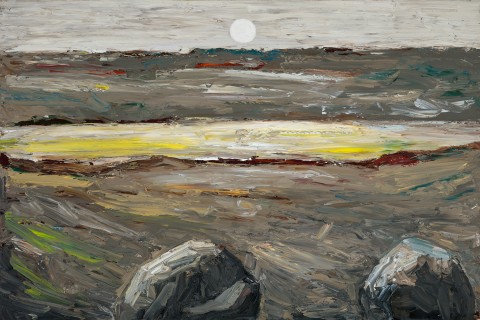PAINTING, 1990
PETER BOOTH
oil on canvas
122.0 x 183.0 cm
signed and dated verso: BOOTH 1990
Tolarno Galleries, Melbourne (label attached verso)
The National Australia Bank Art Collection, acquired from the above in April 1991 (label attached verso)
National Australia Bank Collection: Rivers in Australian Art, Heide Park and Art Gallery, Melbourne, October 1991
The National Australia Bank Art Collection: Rivers in Australian Art, Heide Park and Art Gallery, Melbourne, 1991, p. 19
From his auspicious debut in the ground-breaking exhibition The Field held at the National Gallery of Victoria in 1968, Peter Booth has proceeded to achieve international recognition as one of the most important and influential artists of his generation. Yet if it was his large, monochromatic abstract works which initially attracted widespread acclaim, today it is his immensely vivid and painterly figuration for which Booth is best known. Drawing upon epic legends of the past and prophecies for an imagined future, these dramatic, poetic images of the human spirit poignantly explore fundamental human emotions and anxieties, issues of spiritual turmoil, social alienation and the devolution of civilisation. Thus framed within a world both imagined and observed, Booth's vision transcends the immediate or particular to acquire a universality comparable to the musings of his greatest artistic predecessors, including Goya, Blake and Shakespeare.
Featuring a barren landscape illuminated by a low setting sun in an apocalyptic sky, Painting, 1990 belongs to the acclaimed group of wet and windy 'frozen landscapes' which Booth executed during the 1990s as a sequel to the quiet snow paintings commenced during the winter of 1989. Inspired by the artist's re-reading of Shakespeare's Macbeth (1606) with its chilling themes of ambition and evil bearing resonance for Booth in contemporary Western greed and disregard for the planet, these series represented a transition in Booth's oeuvre which he parallels to the journey in Milton's epic sequence of poems, Paradise Lost (1667) to Paradise Regained (1671). Accordingly, in many such works, ice or snow throws a curtain of silence over the charred and blackened landscape, heralding the end of man's aggression towards his fellow man and the environment in a manner akin to the omen of destruction foretold by the decimation of Birnam wood in Macbeth.
Sombre and desolate, Painting is similarly devoid of life. As Robert Lindsay observes, 'the waves, like coagulating heartbeats of an environment overladen with pollution, slowly move as sludge towards the dead sulphurous shore. It is the twilight of a planet which, as the victim of industrial progress, has seen the extinction of life with only the most adaptable and hardiest of survivors migrating to a new environment'.1 Not surprisingly perhaps, such haunting images have been interpreted as premonitions against 'The Fall', the possible downward trajectory of the present age towards barbarism and eventually extinction. Perceiving in Booth's art a loss of faith in civilisation, critics have thus suggested these works illustrate the 'Iron Age' described by the ancient Greek philosopher Hesiod in his didactic poem, Theogony (8th century BC) – an age of conflict, misery and crime where men respect neither their vows, nor justice, nor virtue.2
1 Lindsay, R., 'Peter Booth: One Hundred Years of Solitude - The New Ice Age' in Peter Booth: Recent Paintings, Deutscher Brunswick Street, Melbourne, 1990, n.p.
2. ibid.
VERONICA ANGELATOS
